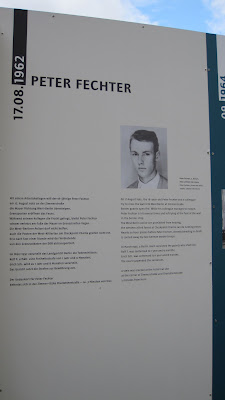And what a transformation. It is now a beautiful city. The old East Berlin, previously grey and dark and menacing, where I once visited with trepidation, is now full of life, with some beatiful new buildings. It is actually ironical that the old part now looks newer than the previously Western parts of Berlin.
But there are deep wounds in Berlin.
I woke up this morning with a radio program on a new Institute for the study of Nazism which has been established in Bavaria. They interviewed someone who recalls the times of Hitler: "The people went crazy," she says. "In our town, some of the people literally went weeks without washing their hands after they met Hitler and shook hands with him. They worshipped the man. Crazy,” she says. “Everyone” was crazy.
It was a time of mass hysteria.
In the Jewish museum last Sunday in Berlin I experienced the offshoots and results of such mass movements again. What an extraordinary museum by Liebeskind. The exhibitions, excellently prepared and informative about Jewish religion, culture and history are not sensational. They are good to see. But the symbolism of the building is staggering, as some of my pictures show(see below).
In the museum, there is disturbing documentation of the suffering of people because of the simple fact that they were Jewish. The holocaust items almost break my heart. It is about violence unleashed in all its anger (cf. Photo’s below).
Will there, I thought, at some moment, ever be something as cruel as this again? And, suddenly I remember the wall – again in Germany and the thousands of people who tried to reach freedom and were killed simply because they wanted to leave their own country. And I remember apartheid, Mashonaland where security people killed more than 20000 Ndebeles in 1985, Srebrenica where more than 8000 men were killed by the Serbs in 1995, and the mass killings in Rwanda. Even if nothing equals the shoa, evil still remains among us, in us and regularly explodes in new forms of murder.
Yes, there will be violence. People have it in them for this to happen time and again. It is not only in Germany where this happens. It happens in our world.
Our hotel where we stay in Berlin is modern. Only later we are told that it was built on the site where the wall once stood. Berlin retained the traces of the wall by building a double brick track in the streets where it once stood (cf. Picture). And, on closer inspections, we see the track and how it surrounds our hotel. What a symbol of the value of freedom, and, also, of how precious humanity is. The symbolism of that track remains with me ever since.
Berlin carries the wounds of the world on its body.
The place where the Berlin wall stood, is marked by a parth of two bricks in the road (on the right hand side, where the cars are parked): what a symbol!Our hotel stood on the location where the wall was.

Note its path around the corner of the opposite sidewalk:

In the museum Liebeskind designed hauntingly beautiful empty rooms to symbolize the absence of Jews from German society:

In another empty room there is a sculpture called "Fallen leaves" by Radeshna. The leaves are faces, made from metal. They cover the floor (10 000) and symbolize the victims of war and violence. I was told by a security guard that visitors are allowed to walk on them. The clanging noise of metal against metal remains with me.


These images from a concentration camp haunt our collective memory:

He was 18 years old in 1962 when he fled his own country to freedom together with his friend. He was shot. Twenty years later the soldier who shot him was sentenced to a year's imprisonment. His name was Peter Fechter. Eighteen years old, yearning for freedom:

No comments:
Post a Comment